Seated movement solutions transform your virtual experiences by dramatically reducing motion sickness through better vestibular-visual coordination while maintaining natural movement patterns. You’ll enjoy extended VR sessions with ergonomic designs that support proper posture and accommodate diverse body types. These gesture-based controls create stronger spatial awareness and presence compared to traditional joystick methods, while making VR accessible to users with mobility challenges. Discover how these innovations revolutionize comfort, inclusion, and immersion in virtual environments.
The Science Behind Illusory Agency in First-Person Perspectives
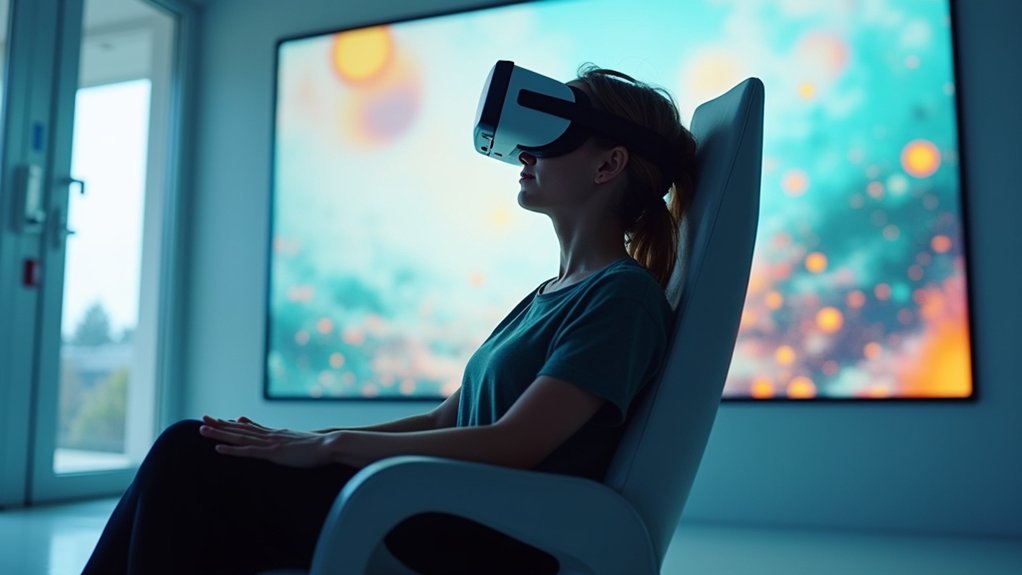
When you slip on a VR headset and watch virtual hands move without lifting a finger, your brain creates a fascinating illusion—you feel like you’re controlling those movements. This phenomenon, called illusive agency, demonstrates how powerfully your perspective shapes perception of control.
Research reveals that first-person perspective dramatically enhances this sense of ownership compared to third-person views. Your brain relies on an efference copy to predict sensory outcomes, but this mechanism doesn’t fully explain illusory agency in virtual environments.
The key lies in visuomotor synchrony—when virtual movements align perfectly with your expectations, you experience stronger feelings of control. However, unexpected sensory feedback, like head sway, can shatter this illusion.
Scientists have documented physiological changes, including voice pitch shifts, that accompany these compelling experiences of virtual agency.
Breaking Physical Barriers Through Gesture-Based Locomotion
You can break free from traditional controller constraints by using intuitive hand gestures that mirror real-world movements, creating a more natural connection between your physical actions and virtual navigation.
These gesture-based techniques greatly reduce the disorientation and nausea that often plague VR users by providing consistent proprioceptive feedback that aligns your body’s expectations with visual input.
When you control movement through familiar gestures like walking in place or pointing, you’ll maintain better spatial awareness and feel more grounded in the virtual environment.
Natural Hand Movement Control
Gesture-based locomotion transforms how you move through virtual worlds by replacing traditional controllers with intuitive hand movements that mirror real-world actions.
When you use natural hand movements in virtual environments, you’ll experience enhanced immersion and spatial awareness that traditional joystick controls can’t match. Systems like Leap Motion detect your hand gestures, converting simple movements into navigation commands that feel organic and responsive.
You’ll find that proxy gestures such as calling and deictic pointing effectively substitute for actual walking, letting you explore expansive virtual spaces without requiring physical room to move around.
This gesture-based locomotion greatly reduces motion sickness while improving your cognitive mapping abilities. Your brain processes these familiar hand movements more naturally, creating better spatial learning and navigation skills that enhance your overall virtual experience.
Reducing Motion Sickness Effects
Since traditional VR movement often triggers nausea and disorientation, gesture-based locomotion provides an effective solution by incorporating proprioceptive feedback that keeps your body grounded while your mind travels through virtual spaces. When you use techniques like Walking in Place or tapping gestures, you’re engaging your body’s natural movement patterns while remaining stationary, considerably reducing motion sickness symptoms.
| Movement Type | Motion Sickness Level | User Comfort |
|---|---|---|
| Traditional Joystick | High | Poor |
| Walking in Place | Low | Excellent |
| Tapping Gestures | Minimal | Very Good |
| VR Strider Pedaling | Low | Good |
| Proxy Gestures | Minimal | Excellent |
This virtual locomotion approach works because your vestibular system receives consistent signals from your controlled movements, preventing the sensory conflict that causes nausea in traditional VR navigation systems.
Enhanced Spatial Awareness Benefits
Beyond comfort improvements, gesture-based locomotion transforms how you perceive and navigate virtual spaces by creating a stronger connection between your physical movements and spatial understanding.
When you use techniques like Walking in Place or cycling biomechanics through systems like VR Strider, you’ll develop enhanced spatial awareness that surpasses traditional navigation methods like teleportation or joystick controls.
This improvement stems from proprioceptive feedback – your body’s ability to sense position and movement. As you perform walking-like gestures or cycling motions, your brain creates stronger cognitive maps of virtual environments.
Research demonstrates that this active movement approach notably improves your navigation skills and presence within virtual reality (VR) experiences, making virtual spaces feel more intuitive and natural to explore.
Enhanced Comfort and Ergonomic Design for Extended Sessions
- Adjustable backrests maintain proper spinal alignment during extended gameplay.
- Customizable seating positions accommodate different body types and preferences.
- Natural twisting motions like the C-Infinity platform reduce physical strain.
- Biomechanical mapping systems such as VR Strider enhance comfort through intuitive movement.
You’ll experience considerably less discomfort compared to traditional teleportation or joystick navigation methods.
Studies confirm that seated locomotion interfaces deliver heightened presence while supporting your body’s natural mechanics.
This enhanced comfort allows you to engage in longer VR sessions without the fatigue typically associated with standing solutions.
Reducing Motion Sickness With Vestibular System Alignment
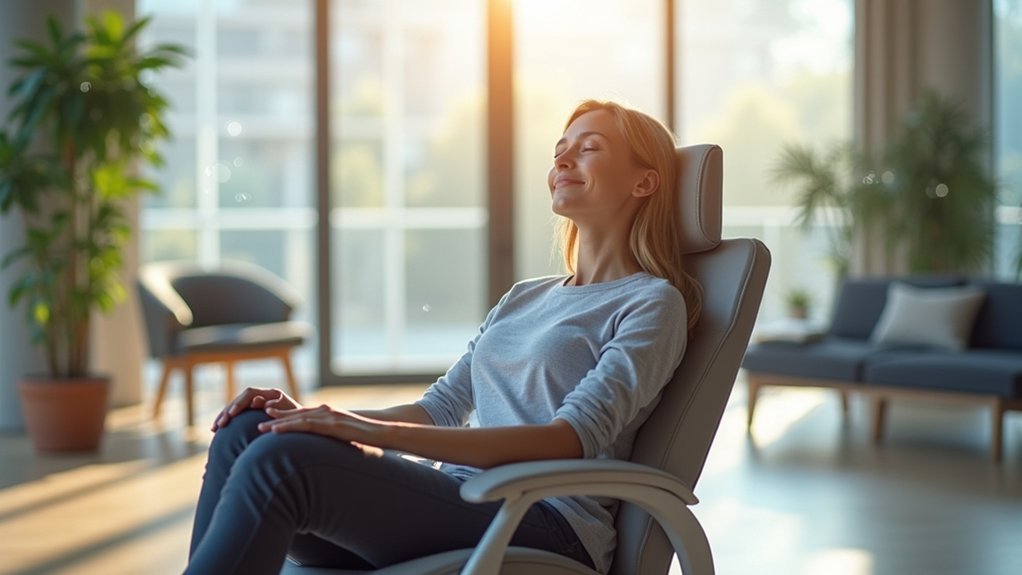
When you’re using VR systems, mismatched signals between what you see and what your inner ear feels can trigger nausea and discomfort.
Seated movement platforms like the C-Infinity address this by synchronizing your vestibular system with visual input through natural twisting motions that mirror how you’d actually move.
You’ll experience considerably less motion sickness because these systems eliminate the sensory conflicts that typically cause VR-induced nausea.
Vestibular-Visual Sensory Synchronization
Motion sickness in virtual reality occurs when your brain receives conflicting signals from your visual and vestibular systems, creating an uncomfortable disconnect between what you see and what your body feels.
Vestibular-visual synchronization solves this problem by aligning these sensory inputs, dramatically reducing VR sickness and enhancing your immersion in virtual environments.
Seated movement platforms achieve this synchronization through:
- Natural motion mimicry – Twisting and tilting movements that match visual cues
- Real-time sensory feedback – Audio and haptic responses coordinated with visual elements
- Controlled vestibular stimulation – Gentle movements that complement on-screen action
- Adaptive comfort settings – Customizable sensitivity levels for individual tolerance
When your vestibular system properly aligns with visual stimuli, you’ll experience increased presence and comfort in immersive virtual reality, making extended VR sessions enjoyable rather than nauseating.
Motion Sickness Prevention
Since your brain interprets conflicting sensory signals as a potential threat, VR motion sickness can quickly transform an exciting virtual adventure into an uncomfortable ordeal.
Seated movement solutions like the C-Infinity VR Locomotion Platform tackle this problem by synchronizing your vestibular system with visual cues through natural twisting motions. You’ll experience considerably reduced nausea when your inner ear sensations match what you’re seeing.
Proprioceptive feedback systems, such as the VR Strider’s pedaling mechanism, provide essential sensory information that aligns with visual stimuli. This integration helps your brain process movement correctly, preventing the sensory mismatch that triggers motion sickness.
Gesture-based techniques like Walking in Place maintain your sense of bodily movement while keeping you stationary, further reducing cyber sickness and physical strain.
Twisting Navigation Benefits
Because your vestibular system naturally responds to rotational movements, twisting navigation creates an intuitive bridge between your physical sensations and virtual motion. This alignment markedly reduces the sensory conflicts that typically cause discomfort in VR environments.
When you use twisting navigation systems, you’ll experience:
- Reduced simulator sickness through better vestibular-visual coordination
- Enhanced control that mimics your natural movement patterns
- Improved sense of presence by feeling more connected to the virtual space
- Greater comfort from ergonomic designs supporting natural postures
Research consistently shows that users report considerably lower motion sickness levels compared to traditional linear locomotion methods.
You’ll find yourself more engaged and comfortable during extended VR sessions, as twisting motions accommodate your body’s natural responses while maintaining immersive gameplay experiences.
Inclusive Gaming Experiences for Users With Mobility Challenges
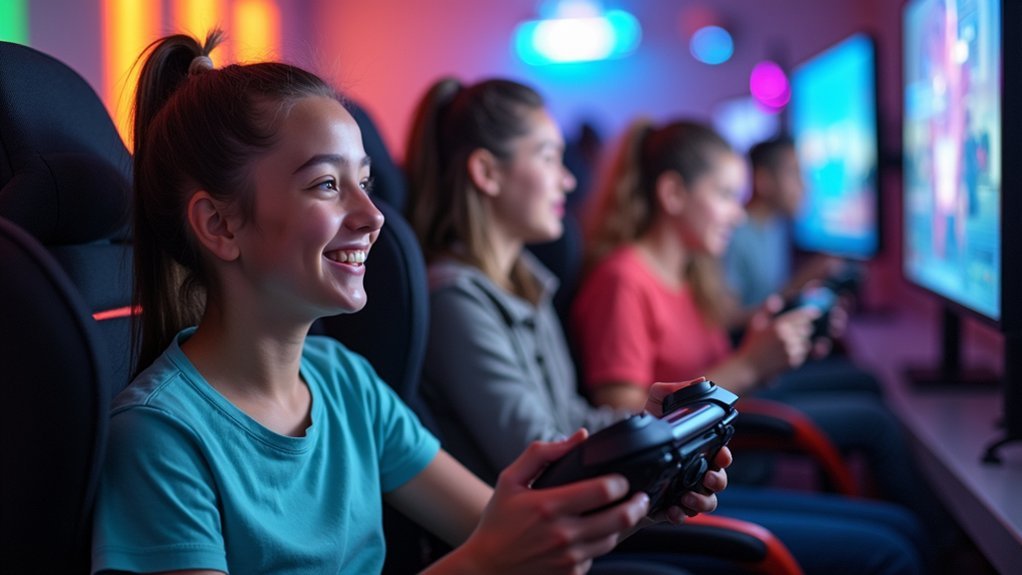
When you’re designing virtual reality experiences, traditional locomotion methods can create barriers that exclude users with mobility challenges from fully engaging with your content.
Seated locomotion techniques revolutionize accessibility by transforming how players navigate virtual worlds. You’ll find that gesture-based controls like tapping and proxy gestures enable effective interaction while users remain comfortably seated, creating truly inclusive gaming experiences.
Research demonstrates that seated movement solutions considerably reduce VR sickness while improving spatial awareness compared to teleportation or joystick navigation.
When you implement cycling biomechanics through devices like VR Strider, you’re translating natural pedaling motions into virtual walking that feels authentic.
Studies reveal no meaningful difference between traditional walking and wheeling experiences, proving that prioritizing accessibility doesn’t compromise immersion or user satisfaction in your VR applications.
Proprioceptive Feedback and Spatial Orientation Benefits
While traditional VR locomotion often leaves users feeling disconnected from their virtual environment, proprioceptive feedback mechanisms in seated movement solutions create a stronger sense of spatial presence and body awareness.
You’ll experience enhanced spatial orientation through cycling biomechanics that improve your angular and distance estimation abilities. Audio-based tactile signals provide essential sensory input that your brain uses for mapping virtual spaces.
Key benefits include:
- Improved cognitive mapping and spatial learning capabilities
- Reduced cyber sickness through better proprioceptive feedback
- Enhanced kinesthetic information similar to real walking experiences
- Stronger sense of presence and comfort in virtual environments
These proprioceptive cues considerably influence how you navigate large-scale virtual worlds, creating a more immersive virtual experience that feels natural and intuitive.
Comparing Performance Across Different Seated Movement Techniques
How do different seated movement techniques stack up against each other in virtual environments? When you’re choosing between movement methods, performance varies greatly across key metrics that directly impact your user experience.
| Technique | Spatial Awareness | Simulator Sickness | User Preference |
|---|---|---|---|
| VR Strider | High | Low | Moderate |
| Gesture-based | Moderate | Moderate | High |
| Audio-tactile | High | Very Low | High |
You’ll find that seated movement techniques like VR Strider excel in spatial awareness compared to traditional teleportation methods. The calling gesture emerges as the most intuitive option for virtual travel scenarios, while audio-tactile feedback systems provide the best immersion by synchronizing physical movements with virtual ground contacts. Your choice depends on prioritizing comfort, presence, or navigation efficiency within your specific virtual environment.
Future Applications and Accessibility Improvements in VR Technology
The evolution of seated VR movement techniques points toward transformative applications that will reshape how you experience virtual worlds across healthcare, education, and entertainment sectors.
These seated movement solutions break down barriers that previously excluded users with mobility limitations, creating truly inclusive virtual environments.
Future developments will revolutionize accessibility through:
- Proprioceptive enhancement systems like LegSense that’ll deliver realistic virtual walking sensations while seated
- Advanced gesture-based controls combining tapping and pointing for intuitive navigation across all user abilities
- Medical rehabilitation platforms utilizing cycling-to-walking biomechanics for therapeutic virtual experiences
- Educational simulations where wheelchair users explore historical sites with the same immersive quality as standing users
These accessibility improvements guarantee virtual walking becomes universally available, transforming VR from an exclusive technology into an inclusive platform that serves everyone’s needs.
Frequently Asked Questions
What Common Movement Options Are Available in a Virtual Reality VR Experience?
You can move in VR through teleportation, smooth locomotion with controllers, room-scale walking, hand gesture navigation, walking-in-place techniques, or specialized devices like exercise bikes that translate physical movements into virtual motion.
How Are Virtual Realities Replacing in Person Activities?
You’re experiencing virtual meetings, concerts, and fitness classes instead of traveling to physical locations. VR’s replacing traditional shopping, education, and social gatherings, letting you participate from home while maintaining meaningful interactions.
Why Does Virtual Reality Enhance Instruction?
Virtual reality enhances your instruction by creating immersive three-dimensional experiences that boost engagement and retention. You’ll find VR reduces cognitive load, improves spatial learning, and increases motivation, leading to better understanding and higher completion rates.
How Virtual Reality Is Transforming the Travel Industry?
You’re experiencing destinations virtually before booking, reducing costs and environmental impact. Travel companies use VR for immersive tours, boosting engagement by 80% while airlines leverage it for staff training and enhanced customer service.

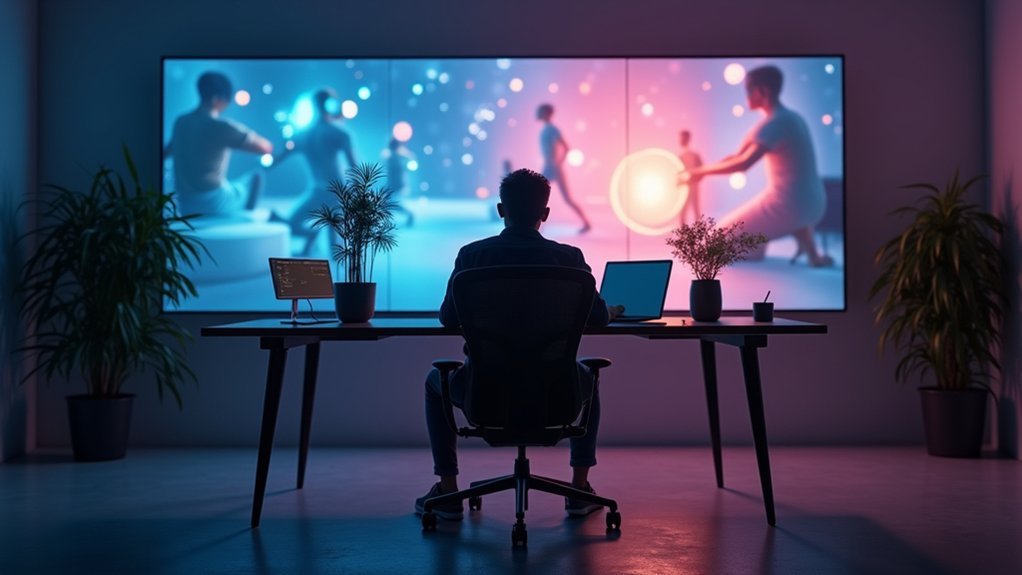

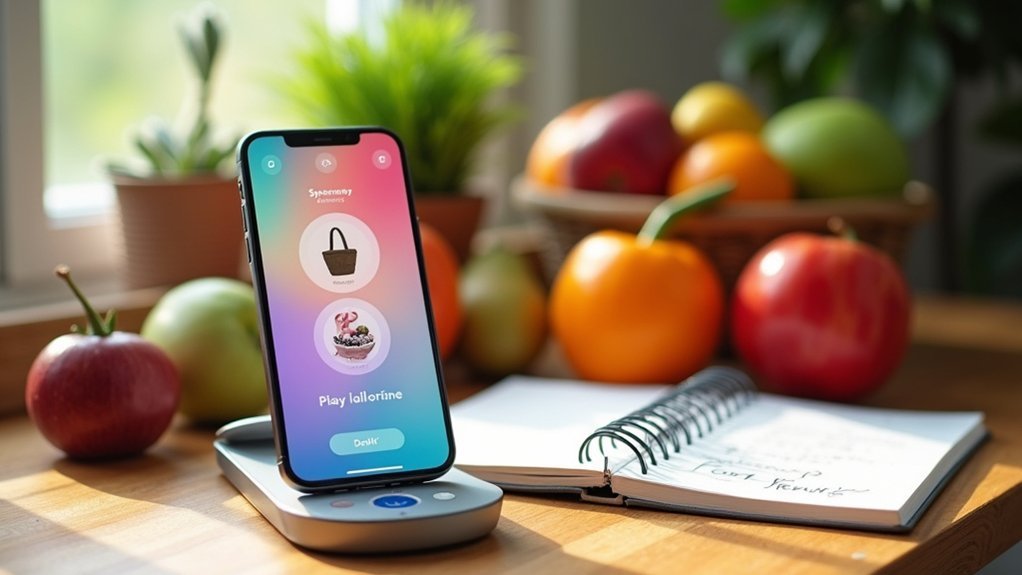
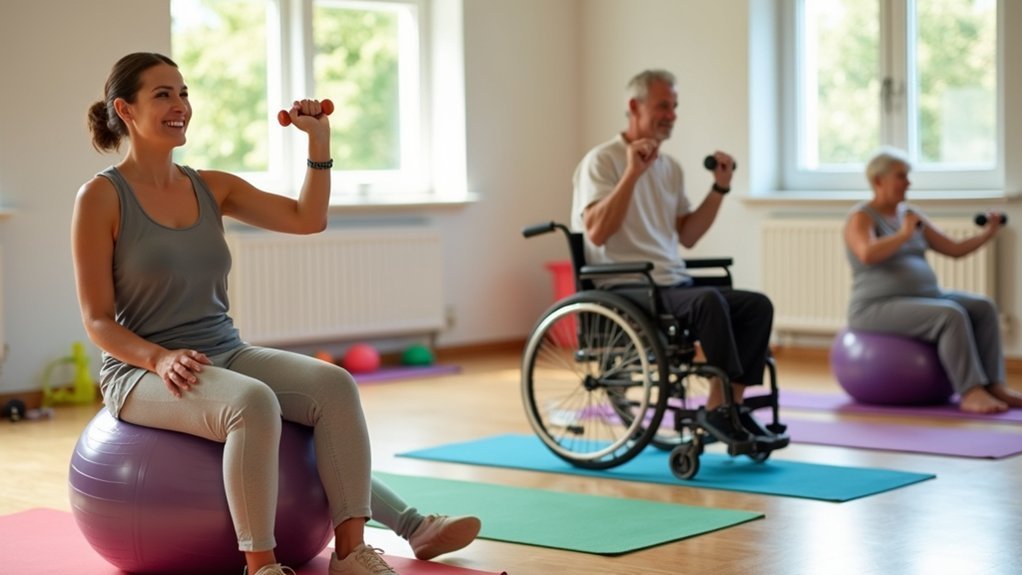
Leave a Reply